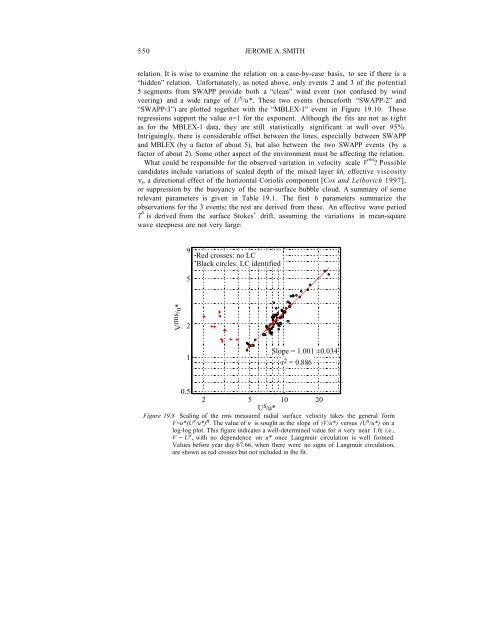Doppler sonar observations of Langmuir circulation - Jerry Smith's ...
Doppler sonar observations of Langmuir circulation - Jerry Smith's ...
Doppler sonar observations of Langmuir circulation - Jerry Smith's ...
- No tags were found...
You also want an ePaper? Increase the reach of your titles
YUMPU automatically turns print PDFs into web optimized ePapers that Google loves.
550 JEROME A. SMITHrelation. It is wise to examine the relation on a case-by-case basis, to see if there is a“hidden” relation. Unfortunately, as noted above, only events 2 and 3 <strong>of</strong> the potential5 segments from SWAPP provide both a “clean” wind event (not confused by windveering) and a wide range <strong>of</strong> U S /u*. These two events (henceforth “SWAPP-2” and“SWAPP-3”) are plotted together with the “MBLEX-1” event in Figure 19.10. Theseregressions support the value n=1 for the exponent. Although the fits are not as tightas for the MBLEX-1 data, they are still statistically significant at well over 95%.Intriguingly, there is considerable <strong>of</strong>fset between the lines, especially between SWAPPand MBLEX (by a factor <strong>of</strong> about 5), but also between the two SWAPP events (by afactor <strong>of</strong> about 2). Some other aspect <strong>of</strong> the environment must be affecting the relation.What could be responsible for the observed variation in velocity scale V rms ? Possiblecandidates include variations <strong>of</strong> scaled depth <strong>of</strong> the mixed layer kh, effective viscosityν t , a directional effect <strong>of</strong> the horizontal Coriolis component [Cox and Leibovich 1997],or suppression by the buoyancy <strong>of</strong> the near-surface bubble cloud. A summary <strong>of</strong> somerelevant parameters is given in Table 19.1. The first 6 parameters summarize the<strong>observations</strong> for the 3 events; the rest are derived from these. An effective wave periodT S is derived from the surface Stokes’ drift, assuming the variations in mean-squarewave steepness are not very large:9Red crosses: no LCBlack circles: LC identified5V rms /u*21Slope = 1.001 ±0.034r2 = 0.8860.52 5 10U s 20/u*Figure 19.8 Scaling <strong>of</strong> the rms measured radial surface velocity takes the general formV~u*(U s /u*) n . The value <strong>of</strong> n is sought as the slope <strong>of</strong> (V/u*) versus (U s /u*) on alog-log plot. This figure indicates a well-determined value for n very near 1.0; i.e.,V ~ U s , with no dependence on u* once <strong>Langmuir</strong> <strong>circulation</strong> is well formed.Values before year day 67.66, when there were no signs <strong>of</strong> <strong>Langmuir</strong> <strong>circulation</strong>,are shown as red crosses but not included in the fit.


